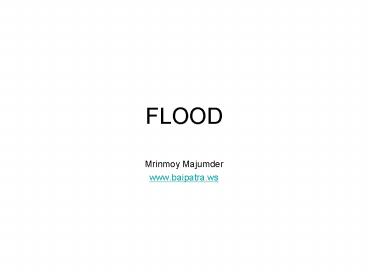FLOOD - PowerPoint PPT Presentation
1 / 20
Title:
FLOOD
Description:
FLOOD Mrinmoy Majumder www.baipatra.ws Definition High stage in river when the river overflows and inundates the adjoining area Flood peak and frequency of the peak ... – PowerPoint PPT presentation
Number of Views:46
Avg rating:3.0/5.0
Title: FLOOD
1
FLOOD
- Mrinmoy Majumder
- www.baipatra.ws
2
Definition
- High stage in river when the river overflows and
inundates the adjoining area - Flood peak and frequency of the peak is an
important consideration in hydraulic design - Magnitude and time of the flood varies with
change in watershed characteristics - Peak flood depends on rainfall, discharge or
watershed area and type - Magnitude of flood can be estimated in
- Rational method
- Empirical method
- Unit hydrograph technique
- Flood frequency studies
3
Rational Method
- Assumptions
- Area of watershed must be less than 50 Sq.Km
- Rainfall continues beyond time of concentration
- Catchment is homogeneous
- The equation for peak flood, according to
rational method - Qp C A i
- Qp is the peak discharge, C is coefficient of
runoff (runoff/rainfall), i is rainfall intensity
which depends on time of concentration and
exceedance probability, A is drainage area in
Sq.Km
4
Time of Concentration
- Rainfall intensity is found to be a function of
time of concentration (tc) and an exceedance
probability P - tc can be expressed as
tp CtL(LLca/(S)1/2)n where, C is a
constant, L is the distance from farthest point
of the catchment to basin divide,Lca is the
distance of gage from centroid of the watershed,S
is slope between farthest point and outlet,n is
the mannings constant
tc 0.01947L0.77S-0.385 where, time of
concentration (minutes),L is maximum length from
farthest point to outlet and S is slope of
catchment(from highest point to lowest point)
5
Rainfall Intensity
- The rainfall intensity is thus represented by
- itc,p KTx/(tca)m
K,a,x and m are constants which can be collected
from frequency duration curves
6
Empirical Formula
- Regional formula
- Based on correlation
- Between flow(Qp) and catchment properties
- Almost all use area(A)
- Neglects flood frequency
- The reason why empirical formulas are all
regional and gives approximate results when
applied to other regions
7
Dickens Formula
- Qp CDA3/4
CD Dickens Formula with value between 6 - 30
8
Ryves Formula
- Qp CRA2/3
CR Ryves Formula with value between 6.8 10.2
9
Inglis Formula
- Qp (124A)/(A10.4)1/2
For Western Ghats in Maharashtra
10
Fullers Formula
- QTp (CfA0.8)/(10.8logT)
For USA,T return period, Cf is a constant 0.18
1.88.
11
Baird and Mcillwraith(1951)
- Qmp (3025A)/(278A)0.78
From maximum rrecorded floods throughout the world
12
Flood Frequency Analysis
- P m/(N1)
- T 1/P
Prn nCrPrqn-r T 1/P
Where P is the probability of an extreme event
and T is the return period of that event. Prn is
the occurrence of the event for r times in n
successive years m is the rank of the event with
respect to other events of the year or decade or
greater time span. N total number of events in
the dataset C combination of n and r and q 1-P
13
Plotting Position Formula
- Probability values can be used to determine the
position of the event in a probability curve.
From which both exceedance and non-exceedance
probability of the event can be estimated.
14
General Equation of Hydrologic Frequency
Analysis(Chow,1951)
- xT x K.s
Where xT is the value of the flood in T return
period x is the mean and s is the standard
deviation K f (T, frequency distribution)
frequency factor
15
Gumbels Method
If f(x) is probability density function,then,Gumbe
ls distribution is given by
Where the distribution has mode a, mean a?ß (
where ?0.5772156649... is Euler's constant),
and variance ?ß2p2
16
Gumbels Distribution Explained
- There are essentially three types of
Fisher-Tippett extreme value distributions. - The most common is the type I distribution, which
are sometimes referred to as Gumbel types or just
Gumbel distributions. - The term "Gumbel distribution" is used to refer
to the distribution corresponding to a minimum
extreme value distribution (i.e., the
distribution of the minimum ). - The Gumbel distribution has a location
parameter a and scale parameter ß
17
Normal Distribution
18
LogNormal Distribution
19
Pearson Distribution
20
Log-Pearson Distribution































